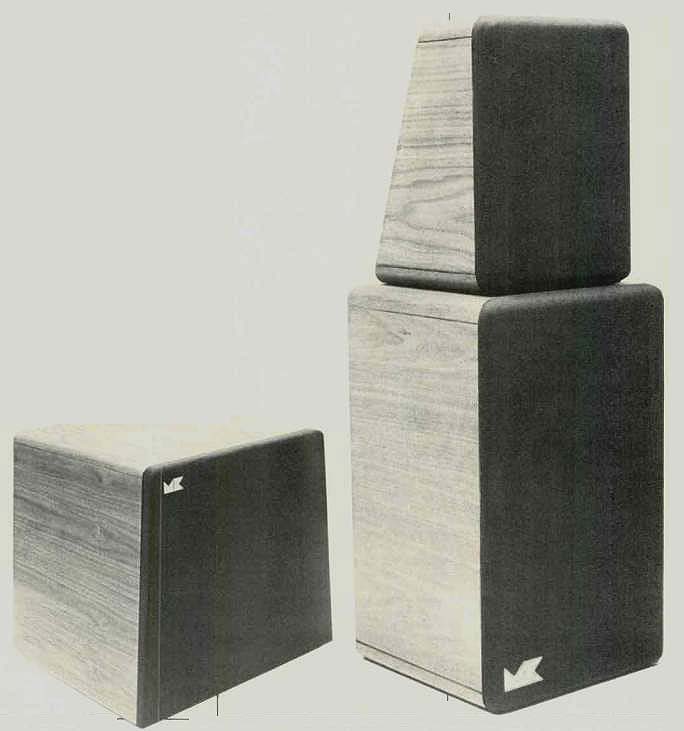
Satellite-1A
Manufacturer's Specifications:
Input Impedance: 4 ohms.
Frequency Response: 55 to 22 kHz, ±3 dB.
Drivers: Two 1-inch domes and two 5 inch cones.
Volkswoofer-A
Manufacturer's Specifications:
Internal Amplifier Power: 60 watts.
Input Impedance: 200 ohms.
Frequency Response: 18 to 100 Hz, ±3 dB, in calibrated position.
Driver: 12-inch dual voice-coil.
Cabinet Finish: Walnut with black grille.
Power Requirements: 120 V a.c., 50/ 60 Hz; idle current consumption, 15 watts; full power consumption, 80 watts.
Dimensions: 17 3/4 in. (45.08 cm) x 18 3/4 in. (47.62 cm) x 15 3/4 in. (40 cm).
Price: $555.00 each.
Minimum Power: 7.5 watts per channel.
Maximum Power: 200 watts with unclipped peaks up to 400 watts.
Dimensions: 21 in. (53.34 cm) x 7 3/4 in. (19.68 cm) x 7 5/8 in. (19.36 cm).
Price: $270.00 each.
The Satellite-Volkswoofer System, introduced by Miller & Kreisel Corporation, consists of a subwoofer physically separated from a pair of smaller satellite stereo speaker systems. Each Satellite uses four driver elements, two tweeters and two midrange units, to cover frequencies above 100 Hz. The subwoofers, called Volkswoofers, carry the range from 100 Hz down to 18 Hz. The Satellites thus carry the directional aspects of stereo imaging, while the Volkswoofer handles the deep bass.
The Volkswoofer tested has an internal power amplifier which contains a feedback circuit to correct for subwoofer nonlinearity and to control response down to subsonic frequencies. A two-meter line cord powers the self-contained amplifier from an a.c. outlet. Main-system power-amplifier signals are routed to the Volkswoofer, which distributes the Satellites' higher frequency components through a built-in crossover network.
A number of modes are available for listening to the Miller & Kreisel Satellite system. The back plate of each Satellite contains four speaker terminals, two positive and two negative, rather than the usual pair. The extra set of terminals, together with a supplied kit of resistors, allows the user to select 14 possible response equalizations. Changing from one equalized position to another involves a minor rewiring to the speaker terminals.
The Volkswoofer is supplied in a separate enclosure which has four input terminals, four output terminals, a three-position bass equalization switch, a level control, and a line cord to supply power to the self-contained amplifier.
There are separate operation manuals for the Satellite speakers and the subwoofer. Even in the case of the Volkswoofer, M & K recommends several possible combinations of external patching capacitors for hookup to main speakers other than the Satellites. In short, the Satellite-1A and Volkswoofer-A involve some fairly complicated setting up, rather than a quick conventional hookup.
It is mandatory that the operation manual(s) be thoroughly read and understood before connecting a single wire from the power amplifier. In addition, although the operation manuals specifically detail which of the multiple connections are to be used for each speaker, the possibility exists for improper connections--either mis-wiring or frayed ends--which may damage either or both the speaker and the owner's power amplifier. I hope that future versions of this excellent system provide greater ease of hookup along with a higher margin of safety against misconnection.
Measurements
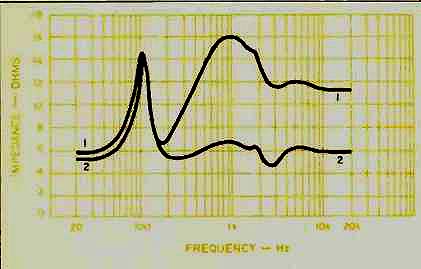
Fig. 1--Terminal impedance for (1) "English" position and (2) two-ohm "German" position.
The four drivers in each Satellite-1A may be interconnected to provide 14 distinct timbral balances through the use of external resistors and jumpers. There are four terminals on the back of each Satellite, and the particular combination of terminals to which the amplifier is connected (and across which the resistors are placed) determines the degree of mid-bass or treble emphasis which the user may prefer. It sounds complicated, and is complicated. Although the 14 combinations are briefly described on a metallic plate placed on the rear of each Satellite speaker, the user would be hopelessly lost without recourse to the more complete hookup explanation provided in the operation manual. This is not a loudspeaker system which should be hooked up without reading the owner's manual.
Figure 1 shows the measured speaker impedance for the "English" and the "German" setups; these are M & K's terminology for the particular sonic balances which result from use of the highest (English) and lowest (German) value of resistors. These represent the extremes of impedance which a power amplifier must drive; other resistor combinations generally fall somewhere between the extremes of these curves.
The full complex impedance plot for the 2-ohm configuration is shown in Fig. 2. While the net impedance above 150 Hz lies between 4.5 and 6.5 ohms, the phase angle is quite small over the entire frequency range. Any good power amplifier should be able to drive the Satellite-1A to the full output rating of the amplifier without difficulty. As with any low-impedance speaker system, care should be taken to minimize wire loss between the amplifier and speaker. This is particularly true in the English position, where the dip in impedance in the octave below Middle C could cause discernible timbre changes with high cable loss.
The one-meter anechoic frequency response is shown in Fig. 3, while the corresponding phase response can be seen in Fig. 4. The 2-ohm configuration was used for these measurements. As a direct quote from Miller & Kreisel's description, this position "gives a sound very similar to the German position with slightly less midrange brightness and efficiency." The German position, to quote further from M & K, "gives a bright forward sound with great efficiency and a very wide dynamic range. Particularly useful for low powered amplifiers required to produce high sound-power levels. Similar to the sound of the best wide-range German manufactured speakers." The microphone was positioned one meter in front of the face of the enclosure for these measurements. The measured air-path delay from the physical location of the microphone diaphragm to the motor of each driver was as follows: Upper tweeter, 3.1286 mS; lower tweeter, 3.1010 mS: upper bass, 3.055 mS, and lower bass, 3.092 mS. The phase measurement of Fig. 4 was made in two parts: One corrected for an observed bass time delay of 3.5053 mS, and the other for an observed tweeter time delay of 3.1742 mS. The actual acoustic crossover of 2200 Hz accounts for 0.455-mS time delay, which, when combined with the mean average physical delay of the bass units, gives the necessary 3.51 mS for proper bass loudspeaker phase measurement. A similar situation prevails for the proper tweeter phase measurement.
The dip in response at 17 kHz is an interference notch caused by a difference in time delay from the two tweeters for this particular microphone location. This notch moves downward in frequency with increasing vertical listening misalignment, and a lower frequency notch comes into play due to the vertical bass drivers. The Satellites should definitely have their vertical plane aligned to point to the preferred listening area in order to provide the most uniform timbral balance for direct sound.
The Satellite-1A is moderately efficient, delivering an SPL in the high 80-dB range for one average watt of drive power (into an assumed resistive load). And, except for the interference notch, the frequency response does lie within the ±3 dB limits cited by M & K.
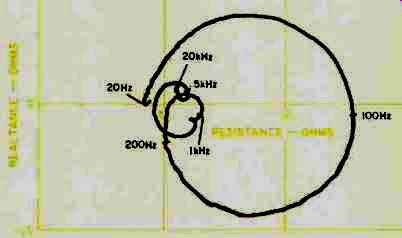
Fig. 2--Complex impedance for two-ohm "German" position.
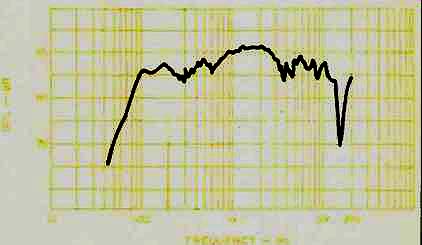
Fig. 3--One-meter anechoic response for constant voltage level corresponding
to one average watt into 4 ohms for 2-ohm "English" position.
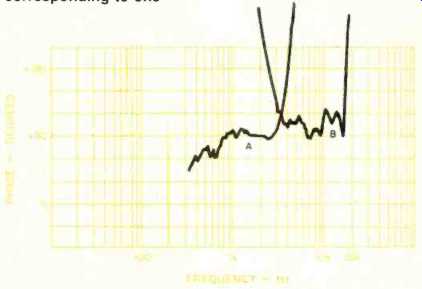
Fig. 4--One-meter anechoic phase response corrected for air-path delay of
(A) 3.5053 mS and (B) 3.1742 mS.
Since it is possible to purchase the Volkswoofer and use it with other systems, I measured its response separately from that of the Satellite, and this is plotted in Fig. 5. Three separate low-frequency cutoffs can be selected by switch positions on the rear of the subwoofer. The "Flat" position is indeed flat, right down to 18 Hz. "Variation A" cuts off frequencies below 30 Hz but introduces a bump at 60 Hz. "Variation B" has a steeper low-frequency roll-off and a couple of dB higher 60-Hz bump. All equalizer positions roll off uniformly at around 6 dB per octave above approximately 120 Hz.
The subwoofer is internally powered by a high-input impedance amplifier, and a gain potentiometer is mounted on the rear of the enclosure. The response in Fig. 5 was made on a relative SPL basis, rather than absolute SPL, because the gain may be selected by the user. Suffice it to say that the variation in gain provided by M & K is great enough that an 8-volt peak-to-peak drive signal (corresponding to an average power of one watt into 8 ohms) is sufficient to provide acoustic sub-bass match for any speaker system to which this unit might be matched. If the Volkswoofer is used with speaker systems other than the Miller & Kreisel Satellites, care should be taken to filter or equalize those systems so they do not reproduce the same bass frequencies as the subwoofer. Failure to do this could cause severe bass imbalance, which would be particularly noticeable with the Volkswoofer due to the large amount of gain control made available to the user. The bass response of almost any passive speaker system can by overpowered by this subwoofer to give a false sense of uniform low bass, but phase interferences might cause bad notches and peaks in the mid and upper bass regions where the Volkswoofer begins to fall off. And, as with spices added to a fine dinner, add just enough subwoofer power to give true sonic, deep bass balance. Too much bass may shake the house and impress the neighbors but contribute nothing to the accurate reproduction of a performance. The proper balance is often low enough that you may think the sub woofer is not functioning-until you cut it out and realize the deep bass foundation it truly provides.
The measured three-meter room response is shown in Fig. 6. The speaker was elevated one meter above the floor so that the intersection of the two cabinet sections was at nominal listening height. Measurement was made at a listening distance of three meters, and the response in Fig. 6 corresponds to the frequency spectrum of the first 13 mS of sound which reached the listening position. An on-axis and a 30° left-channel stereo position were measured, and the two curves are displaced 10 dB apart for clarity of presentation.
The stereo position provides a moderately good spectral balance for room listening, although some upper midrange brightness can be expected, according to this measurement. The Satellites should not be toed in toward the nominal listening position; an off-axis stereo location provides more uniform direct sound in a room. The room response shows the same small emphasis in the 800 Hz to 4 kHz range as the anechoic response. Conventional tone controls will be unable to smooth this bump, though either parametric or narrow bandwidth equalizers could be used to tame this small defect.
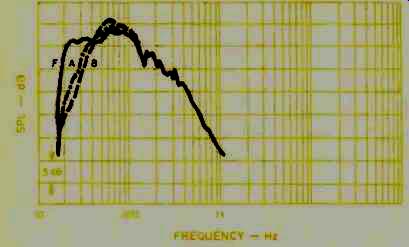
Fig. 5--Volkswoofer frequency response for "Flat" (F), "Variation
A" (A), and "Variation B" (B) positions.
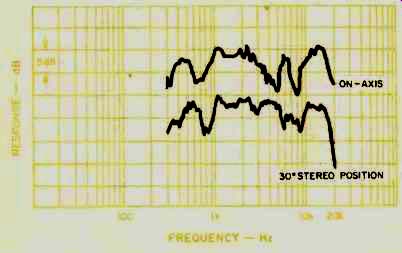
Fig. 6--Three-meter room response.
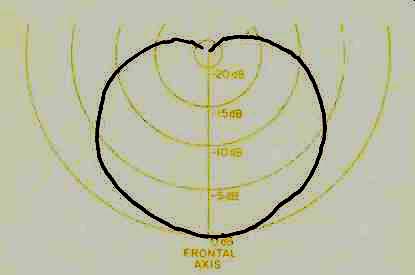
Fig. 7--Horizontal polar energy response.
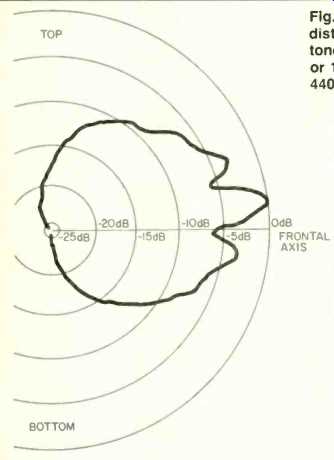
Fig. 8--Vertical polar energy response.
Horizontal and vertical dispersion of sound is shown in the polar energy plots of Figs. 7 and 8 respectively. Horizontal (left-right) uniformity of sound was quite good within 30° of the frontal axis of the Satellites, indicating that lateralization should be quite good in stereo imaging. Because of the wide angular dispersion of sound, the Satellites should not be placed next to walls or other substantial objects which could reflect sound back toward the listening area. Vertical (up-down) dispersion showed lobing due to the physical geometry of drivers used in the Satellite system.
Some change of timbre will be noted as one moves up and down relative to the vertical plane of the Satellites, so they should not be placed with their front axes pointed significantly above or below the nominal listening position, and under no circumstance should the two Satellites be mounted at different heights relative to each other. Because there is a significant amount of sound launched upward, the Satellite speakers should not be placed directly beneath shelves or overhanging objects which can reflect sound back down to the listening location.
The Satellite systems handle frequencies above 100 Hz, while the subwoofer reproduces the lower bass tones. Harmonic distortion for fundamental tones of E, (41.2 Hz), A2 (110 Hz) and A4 (440 Hz) is plotted in Fig. 9. The A2 and A4 measurements were made on the Satellites, while E, was made on the Volkswoofer.
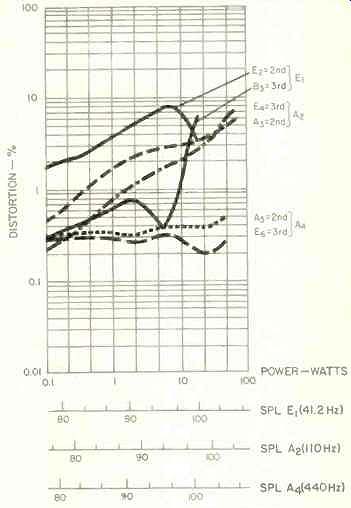
Fig. 9--Harmonic distortion for the musical tones of E1 or 41.2 Hz, A2 or 110
Hz, and A4 or 440 Hz.
The harmonic distortion properties of the Satellite are unusual. Second and third harmonic components are essentially the same for A2, rising uniformly with increasing drive power, while the distortion components of A4, although alike, remain constant up to the maximum test level.
This suggests apparent changes of timbre and loudness for A2 relative to A4 for a change in drive power. For example, a 10-dB increase in power level will approximately double the percentage of second and third harmonic of A2, but will produce no change in partials for A4. This sonic effect has no name, but it may constitute a minor veiling distortion on an otherwise clean performance.
Volkswoofer harmonic distortion was plotted on the same average power scale as Satellite distortion, which is a bit misleading since the Volkswoofer is driven from a self-contained power amplifier. In order to make the measurement, I connected the entire system as a working unit and adjusted the one-meter, free-field 41.2-Hz sound pressure level by the control on the rear of the Volkswoofer to match that of the Satellite at 440 Hz. The resultant measurement represents a complete system with amplifier drive voltage corresponding to the equivalent average watts into a 4-ohm resistor. Sonic stress began to occur at around 95 dB for the Volkswoofer due to the high excursion of the cone required to produce this pressure level.
Intermodulation distortion measurements for the Satellite system are plotted in Fig. 10. Since tones below approximately 90 Hz are handled by the subwoofer, the low tone used for this test was E2 or 82.6 Hz. This low tone was then added to A4 (440 Hz), and the modulation of A4 produced by E2 was measured as a function of drive power. The Satellite has an IM composed of both phase and amplitude modulation of A4 by E2. At 10 average watts, there was approximately 2% peak-to-peak amplitude modulation and 3° peak-to-peak phase modulation. This increased uniformly to about 5% and 5°, respectively, at 100 average watts.
The IM is modest at high power levels, but at lower listening levels it is a little higher than I would prefer to see in such an otherwise high-quality system.
The Satellite acoustic transfer gain, which is the ratio of the change in sound pressure produced by a change in drive voltage, remained steady at all levels for the test tones of Middle C (262 Hz) and A4 (440 Hz). The tone of A2, however, produced slightly less than a 1-dB increase in sound level for a 1-dB increase in drive voltage; starting, from a relative base of 10 mW, the 10-watt sound pressure level was down by 0.5 dB. This implies a slight compression of lower bass tones relative to upper partials for loud passages, but the amount of compression is so small as to remain essentially inaudible.
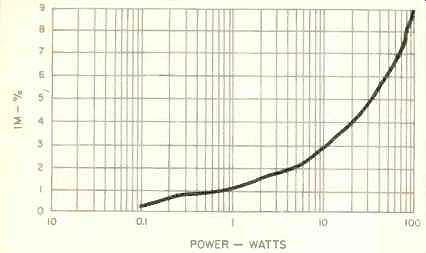
Fig. 10--IM distortion for the tones of E2 (82.6 Hz) and A4 (440 Hz) mixed
in a one-to-one ratio.

Fig. 11--Energy-time response.
The Satellite performed extremely well in the crescendo test. A sudden burst of wide-bandwidth incoherent noise did not reduce the level of a single tone, even when the tone had an average level 20 dB below that of the noise burst. Test tones of A2 (110 Hz), Middle C (262 Hz), and A4 (440 Hz) evidenced no change even up to combined signal-plus-noise peaks of 600 watts. Therefore, sudden trumpet bursts or cymbal crashes will not produce timbral changes or stereo shifting of unrelated solo instruments in the stereo field.
The energy-time response of the Satellite system is shown in Fig. 11. This 1s a measure of the total energy density of the sound pressure at a one-meter axial location caused by a perfect electrical impulse fed to the loudspeaker terminals. The first sound peak at 3.15 mS is due to the tweeters; subsequent peaks are due to internal reflections within the grille assembly. The main peak of the lower frequency driver's response occurred at around 3.5 mS. The impulse response quickly damped to a low value by the end of 4 mS and remained at this level with only a few internal acoustic reverberations in evidence thereafter. This is a moderately good impulse response, even taking into account a time spread of 0.5 mS due to arrival time differences between tweeter and midrange units. The percussive properties of impulsive sounds may suffer a small coloration in the 2 to 10 kHz range because of the discrete energy peaks separated in the 0.5 to 0.1 mS intervals shown in this test.
Use and Listening Tests
Some experimentation was necessary to provide proper room placement for auditioning the Satellite and Volkswoofer combination. I used two Volkswoofers for the listening test and also attempted each of the combinations of Satellite equalization. The equalization I finally used is that which M & K refers to as "high-efficiency low-tweeter level subdued 'German Dome' sound." Esoteric description to the contrary, this gave the most accurate sound to my ears.
The Volkswoofers were placed directly beneath the Satellite-1As, which were mounted one meter off the floor.
My overall impression of the complete system, Satellite and Volkswoofer, is that the Volkswoofer is really the star performer of the two in terms of uniformity and accuracy of sound. To my ears at least, I could not get completely accurate timbral balance for the upper midrange and treble portions of the spectrum. The sound was clear, overall stereo imaging was excellent, and the system handled enormous peaks without breakup, but piano and human vocal didn't present a strong illusion of sonic presence, in my opinion. However, these last two tests are among the most difficult for a speaker.
Part of this relates to a change of instrumental timbre with listening position relative to the Satellite speakers. There is a preferred listening position, as M & K points out in their brochure, and when one is in this specific position, the sound can be equalized to be reasonably accurate. Moving away from this position, particularly up or down, alters the tonal balance.
The Volkswoofers, on the other hand, do not need to be so carefully positioned. They deliver accurate sound, within their tonal range, from almost any reasonable room location, and go right downstairs to deliver solid low bass. This deep response together with, say, a low organ pedal note on a warped record or someone walking past a poorly mounted turntable, can drive the cone to its excursion limits and perhaps beyond, so that a user should be aware of this possibility.
An electric fan is the only transducer capable of reproducing d.c., but the Volkswoofer made a valiant effort a couple of times when I was playing old records and turned the volume up to high levels. Noticing a strange burbling sound coming from the subwoofers, I pulled the grille off, which revealed a cone just about ready to jump into the room. The poor Volkswoofer was vainly trying to be an electric fan. This was stopped by switching the rear-mount ed equalizer out of the "Flat" position, though this was the position which seemed to me to produce the most accurate sound.
I was able to improve the sonic accuracy of another fine loudspeaker system by using the Volkswoofers as add-on subwoofers. In this role the Volkswoofers stand on their own very well, and I can genuinely recommend using the Volkswoofers for low bass augmentation on even the very finest loudspeaker systems.
-Richard C. Heyser
(Editor's Note: M & K informs us that they will shortly be offering a new Satellite-1B incorporating two six-position rotary switches which will allow quick selection of 42 sonic characteristics. These switches will replace the external resistor kit and add additional flexibility. The system also will use new proprietary polypropylene drivers and have new push-type input terminals, which will accept the heaviest gauge wires as well as standard banana plugs. In addition, a newly designed Volkswoofer-B will incorporate a 400-watt amplifier as well as additional line-level inputs, which will allow the subwoofer to be driven from a preamp. -E.P.)
(Source: Audio magazine, Apr. 1982)
Also see: